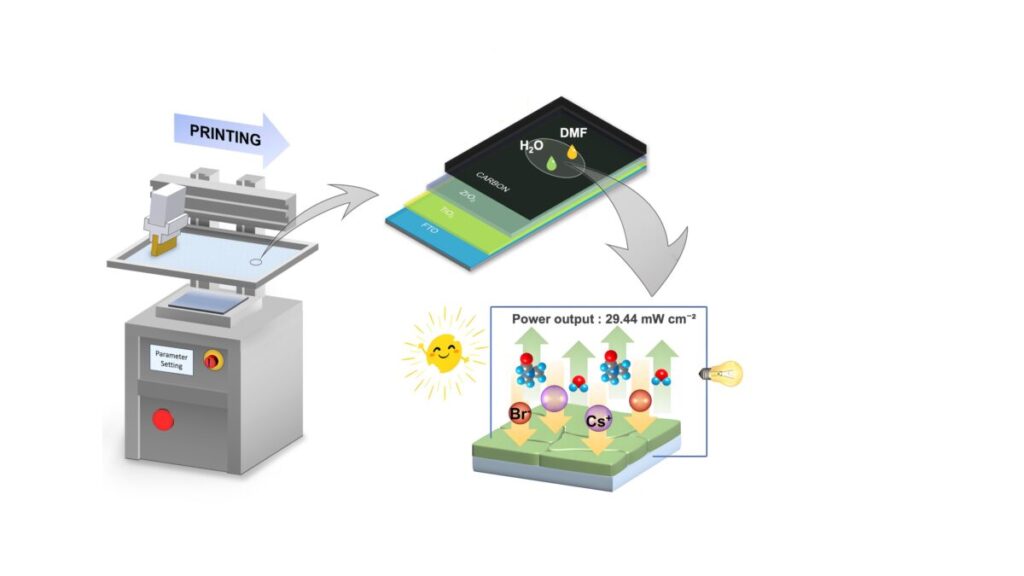A team of researchers in China has demonstrated a new dual solvent process in 4-terminal carbon CSPBBR3 Perovskiet solar cells that achieve 10.18% power conversion efficiency. They have also built a large area of 17.88 cm2 that achieves an efficiency of 8.72%, while 93.2% of the initial performance is retained at 150 ° C after 1,000 hours of work.
Researchers from the East China University of Science and Technology have developed a new production approach with double solvents for solar cells and modules of Perovskiet in an attempt to improve their stability.
“Our research used innovatively a dual-solution-engineering approach within a two-step process to increase the wealth conversion-efficiency of printed mesoscopic CSPBBR3-based perovskiet solar cells to a record-breaking 10.18% Wu,” told the corresponding author, told, told, told, the corresponding author, told the corresponding author, wenjun, told, wenjun, wenjun, wenjun, wenjun, wenjun, wenjun, wenjun, wenjun, wenjun, wenjun, wenjun, wenjun, wenjuneur, wenjune. PV Magazine. “Moreover, by integrating a reflective device of four terminally, we successfully increase the output power to 29.44 MW CM-2.”
The researchers noted that earlier studies have established water as a suitable solvent when forming CSPBBR3 Perovskiet based on the suitability of its donor number and dielectric constant, but also that it had shortcomings at the level of film quality and device performance. They used the DFT calculations of the Density Functional Theory (DFT) and Tyndall effect analysis to tackle the limitations. Their new dual-solvent engineering strategy included N-Dimethylformamide (DMF) as a co-solving agent.
“By selecting carefully solvents with improved donor numbers and dielectric constants, the surface/PB ratio of CSPBBR3 was effectively modulated, so that P-type transition was induced and defective formation within the perovskiet film,” the researchers said.
Screen print was used to manufacture the all-in-organic carbon-based mesoscopic perovskite solar cells. Their performance was made with those of reference cells made with a more conventional watery process.
The technology was demonstrated in an all-in-organic carbon-based printable mesoscopic perovskite solar cell that achieved a record power conversion efficiency of 10.18%. In addition, the scientists built a large device of 17.88 cm2 that achieved efficiency of 8.72%.
The treatment made ‘remarkable improvements’ possible in the dynamics of the carrier, reduced defect densities and improved device performance, according to the research team. The stability tests showed that 93.2% of the initial efficiency was retained after 1,000 hours of operation at 150 C.
To improve the ability, the scientists integrated the 4-terminal cell with a mirror concentrator device to reach 29.44 MW CM2. “Our findings form a promising route to powerful and stable all-in-organic perovskite solar cells that are suitable for large-scale applications,” the team concluded.
The work is described in detail in “Reaching unprecedented power output in 4-terminal mirror-symmetrical printable carbon CSPBBR3 solar cells via dual-solving engineering“Recently published in Energy and environmental science.
“In the future, we are planning to continue to improve the photo-electric conversion characteristics of the devices by optimizing the crystallization process, screening of passivating systems and the development of efficient collections of lamp collection and user equipment. We also want to explore applications in the future of a large area,” said WU, said WU, said WU, Said, Said.
This content is protected by copyright and may not be reused. If you want to work with us and reuse part of our content, please contact: editors@pv-magazine.com.

